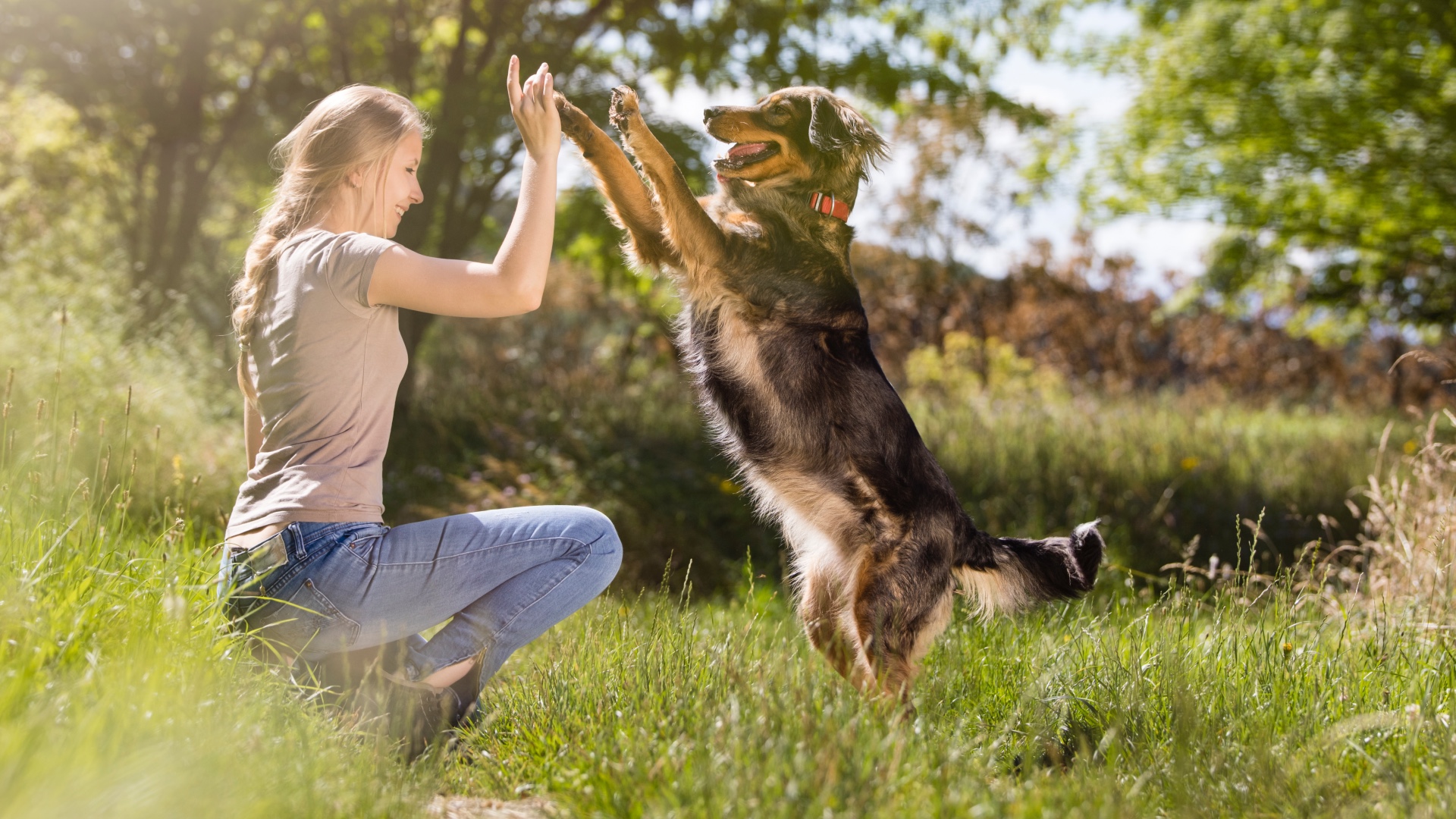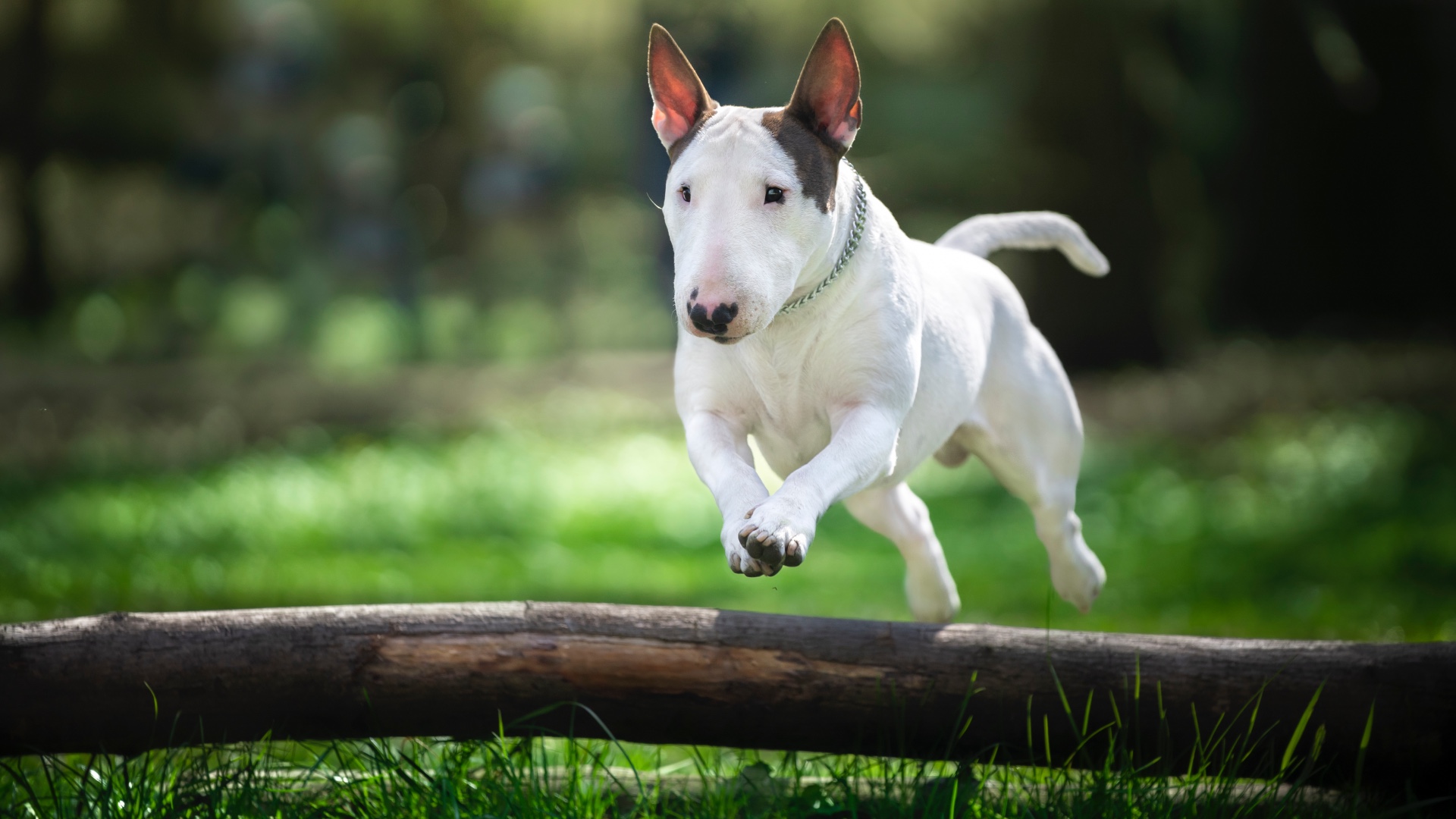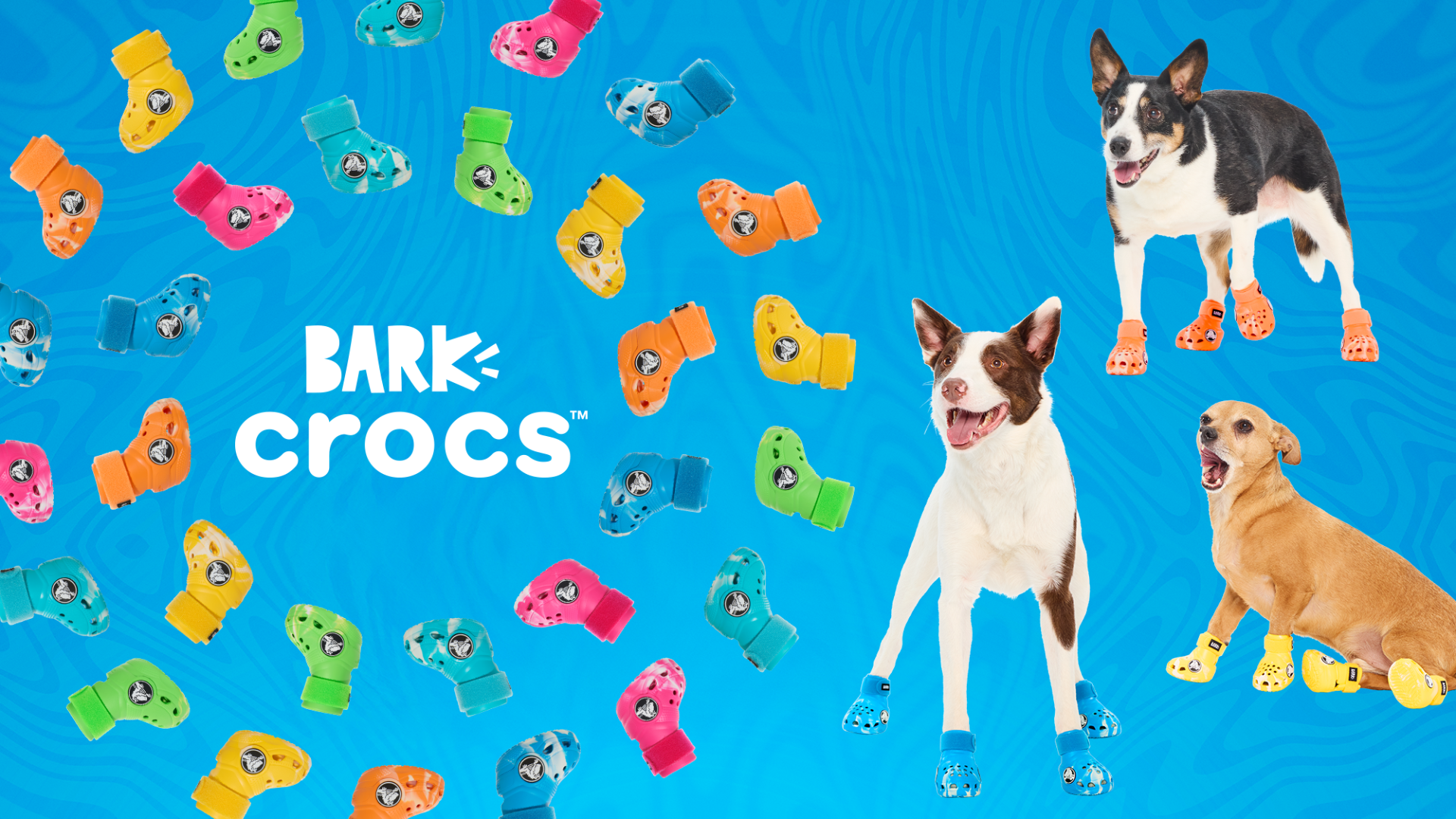10 great brain games for dogs
These vet-approved brain games for dogs will give your pup a great mental workout and help them learn new skills too!

Brain games for dogs are a wonderful way to give your pup's mind a good workout. While physical exercise is super important, mental stimulation and enrichment is also vital for your dog's health and wellbeing. Not only can brain games help to banish boredom and prevent destructive behaviors, they're super fun too!
If you've been pondering the reasons why your dog's recall isn't reliable or tearing your hair out because your canine companion has strewn their toys all over the floor, we have great news — as well as providing your pup with mental exercise, brain games can assist them in learning new skills. And they're great for helping senior dogs stay alert and active.
Below, expert vets Dr. Joanna Woodnutt and Dr. Hannah Godfrey discuss the benefits of mental stimulation, what dog breeds benefit most, and share some of their favorite easy games that require very little equipment or setup. So, grab a bag of the best dog treats (you'll need them for many of these fun activities!) and let's dive in...

After graduating as a veterinarian from the University of Nottingham, Dr Joanna Woodnutt went on to practice companion animal medicine in the Midlands, UK. Dr Woodnutt is specifically interested in consulting and helping her clients understand their pets better, whether it’s around medical problems such as dermatology, behavior, and nutrition.

Dr Hannah Godfrey is a small animal vet who graduated from the Royal Veterinary College in 2011 and began work straight away at a busy mixed practice. Initially, she treated all species, but focussed on small animals from 2014. She has a passion for soft tissue surgery, ultrasound, and canine and feline dentistry, having completed additional training in these areas.
What are the benefits of brain games for dogs?
1. Can help reduce frustration, boredom, and destructive behavior
"Keeping your dog occupied and stimulated will help to prevent boredom, which can lead to chewing, scratching, and other destructive behavior," says Godfrey.
"While chewing household items causes damage to your property, it also poses a health risk to your dog. I have seen many dogs in practice who have chewed up items of clothing, toys, or even furniture and have subsequently required surgical treatment to remove foreign material from their stomach or intestine."
2. Encourage independent play
Get the best advice, tips and top tech for your beloved Pets
"This is particularly useful in puppies but applies to any dog who struggles in moments without your company and attention. This doesn’t just reduce boredom; it also builds your dog’s self-confidence and may reduce separation anxiety over time," explains Godfrey.
3. Improve or maintain your dog’s memory and cognitive ability
"As humans, it’s noted that regular brain ‘training’ can help to maintain cognitive function during the aging process, and this may also be true for dogs. Therefore, giving your dog regular brain training tasks can keep them on the ball (so to speak) and may reduce or delay signs of cognitive decline associated with age," Godfrey says.
How do you mentally stimulate a dog?
"There are lots of ways to encourage your dog to use his brain and stimulate him mentally," says Woodnutt. "Some are simple, like letting him sniff on a walk. Others are more difficult, such as training or canine sports.
"Whilst some types of mental stimulation need specialized equipment, the vast majority don’t – and since every dog should have some sort of mental stimulation, it’s all about finding the right brain game for you and your dog."
Do brain games tire your dog out?
"All types of mental stimulation are tiring for dogs – just as school is tiring for humans," Woodnutt explains. "Learning new things requires effort and energy, as does putting the brain to work solving puzzles.
"Our modern dogs lead luxurious lives, but one downside of this is that they can quickly get bored and lazy. Adding brain games to your dog’s routine is a great way to tire him out."
Which breeds benefit most from mental stimulation?
"Young dogs and those with high energy levels will benefit most from mental stimulation. This would include working dogs like spaniels, Labradors, and beagles," says Godfrey.
"However, mental stimulation and enrichment will have a positive effect on the majority of dogs and can encourage more activity in dogs who are often sedentary. This means it’s a great idea for dogs who have mobility issues or are recovering from surgery."
What brain games can I play with my dog?
"Even if your dog isn’t likely to hold world records for intelligence, it’s still important for them to use their brain. In fact, mental exercise is good for behavior and may even help to slow the onset of dementia," says Woodnutt.
So, what brain-training games can you try with your dog? Below, Woodnutt has listed her tried-and-tested top brain games that her own dog loves and we're confident that they'll get the big paws up from your own canine companion!
Brain games for dogs
1. Find the treats
What you'll need: A packet of dog treats | Duration: 10 minutes
- Hide a few dog treats around a room in your house
- Tell your dog to 'find the treats', giving encouragement as you do
- Once you've played this game a few times with your dog, increase the difficulty by hiding the treats in more challenging places
This game allows your dog to use their most powerful sense – their nose – and engages the parts of their brain used for sorting scents.
"The length of time that this game takes will depend on how good your dog is, and over time they’ll get better and better at it," says Godfrey. "This means you’ll have to find better hiding places or even use a snuffle mat to hide the treats.
"Because this game uses food, it’s important not to overdo it, or else your dog will gain weight. Initially, this game could take ten minutes or more, but rather than using time as a guide, ensure you’re using the same amount of food, even as they get better at it.
"It’s important to always factor this food into your dog’s daily calorie allowance, so you might decide to use a handful of their daily kibble for this instead."
2. Which cup?
What you'll need: Two or more cups, some dog treats | Duration: 10 - 15 minutes
- Place some treats under a cup
- Say 'which cup' and then wait for your dog to look at or put their nose on the cup
- Lift the cup up as soon as they've selected one, allowing them to have the treat
- Once they've got the idea that 'which cup' means they should indicate the cup containing a treat, you can add more cups and even move them around slowly so your dog has to work harder to indicate the right cup
This is a fun game that works on your dog’s patience and impulse control as well as their focus – they’ll be watching you like a hawk when you try to mix up the cups.
"Again, as your dog gets better at this, they’ll get much quicker. However, it’s also more likely to engage them for longer once they get the hang of it," Godfrey suggests.
"You could aim to spend 10 to 15 minutes playing this game, but the most important thing is not to get carried away and give them too much extra food!"
3. Learn a new trick

What you'll need: A pinch of patience! | Duration: 10 minutes
You might be thinking that this isn’t really a game, but all tricks and commands should be taught in a fun way – and they are certainly good brain training. This doesn’t have to be a ‘serious’ command like recall or sit – why not pick something fun? If you’re stuck for trick ideas, you could choose one of the following:
- ‘Spin’ and ‘twist’ – a clockwise and counter-clockwise turn. It’s extra-impressive if they can go both ways
- ‘Shy’ – dog paws at his nose as if shy
- ‘Speak’ – teach your dog to bark on command. This one is useful as it’s also the first step in teaching your dog not to bark at all
- ‘Bow’ – if your dog knows a few tricks, they’ll need the bow command for the end of their performance
"Learning a new trick isn’t easy for every dog, and it requires patience from both you and them," says Godfrey.
"It’s a good idea to be consistent and work on the trick regularly, around ten minutes every day or every other day would work. However, if your dog keeps losing interest before the ten minutes is up, come back to it another time. And don’t forget to give plenty of encouragement."
4. Towel roll
What you'll need: An old towel, some dog treats | Duration: 30 minutes
- Lay an old, clean towel on the floor
- Spread dog treats over it
- Roll up the towel so that the treats are spread in each layer
- Give it to your dog and let the figure out how to unroll the towel in order to get the treats
- To make this game extra hard, you can use several towels
"This game could keep your dog entertained for half an hour or more, especially when they’re new to it!," says Godfrey. "It's great when you want a longer form of mental stimulation and to encourage independent play, because you don’t need to worry so much about overfeeding them – the effort they have to put in to find each treat/dog biscuit means that you don’t need to use too many."
5. Which hand?
What you'll need: Dog treats | Duration: Two to three rounds
- Hide a treat in one hand
- Offer both hands to your dog
- Ask him to choose one
- When your dog indicates the correct hand, open it to reveal the treat and let him eat it
- Repeat two-three times, making it more difficult as you go
"This game is quicker than the ‘which cup’ game, as you can’t very easily switch hands during the game (doing so behind your back too many times could lead to frustration)," explains Godfrey. "Since a treat or food is required for each round, it’s best not to play this for more than two or three rounds at a time."
6. Dog parkour

What you'll need: Whatever is in your environment | Duration: 30 minutes or more
- Teach your dog some basic commands - to go over things, under things, weave and to walk along a narrow wall or similar
- Once your dog has got the hang of these, add a bit of parkour into your daily walk (a combination of energetic exercise and brain work)
- Ask them to leap onto the wall and walk along it, weave through bollards, or crawl under the slide in the park
"This game requires complete focus on you whilst your dog waits for the next command," says Woodnutt.
Godfrey adds, "Since this game involves physical activity too, there’s less risk of overfeeding and weight gain. This means you can safely play this game for half an hour or more, as often as you and your dog would like!"
7. Learn a new word
What you'll need: Dog toy | Duration: Train in short bursts
- Choose an unnamed toy
- Play with the toy often, using the word 'teddy' whenever you instigate the game
- Start to leave teddy out of reach and say 'teddy', then reward your dog for looking towards or picking up his toy
- Soon he'll have the hang of all his toys and you'll be able to start naming other objects, like 'slippers'
"This game works on your dog’s memory and improves his ability to learn," says Woodnutt.
"Depending on whether you reward your dog with praise, a fuss, or food, and how far away the objects are that they are retrieving, you might want to modify how long you play this game for to avoid inadvertently giving too many treats," adds Godfrey.
"However, in the early stages when learning a new word, it’s best to mention the new word often and train in short bursts."
8. Hide and seek
What you'll need: Just your imagination! | Duration: 10 - 15 minutes
- Tell your dog to sit and stay (or have a family member hold onto him)
- Go and hide and then call your dog
- Praise him when he finds you
- Step it up a notch after a few rounds and hide in more difficult places (under the bed or up high) or have several people hiding that your dog has to find
"A great game for rainy days, with children, or for dogs working on their recall, hide and seek is simple and requires little set up or training," says Woodnutt.
"Your dog will be using energy as they search for you (as long as you’re good at hiding!), so you don’t need to worry so much about giving them too many treats," Godfrey adds.
"Equally, many dogs will play this game just for the excitement and verbal praise they receive when they find you. Depending on how good your dog is at hide and seek, you could play this game for 10 or 15 minutes; but be sure not to cause them anxiety or frustration by making the game too hard."
9. Putting away toys
What you'll need: Any toys lying around the house | Duration: As long as you like
"After all that play, there might be a bit of a mess. Teaching your dog to put away his own toys can take time – but watching them learn is part of the fun!," says Woodnutt
- Before you start teaching this game, ensure your dog is well versed in the 'drop it' command
- Get your dog to pick up a toy near his basket and ask him to 'drop it' as he moves close to, or hovers over, the basket
- Reward him every time he gets close, giving him extra praise if the toy goes into the right place
- In time, you'll be able to ask him to tidy up his toys after a play session
"This game will take much longer in the beginning, and you might only be able to persuade your dog to pick up and drop one toy," says Godfrey. "However, as they learn, you could spend up to ten minutes tidying toys."
10. Chase the treat
What you'll need: Dog treats | Duration: Up to 15 minutes
"One of the easiest games to play, with almost no training involved, is ‘chase the treat’. It’s good fun and allows your dog to practice recall and coming back to you," says Woodnutt.
- Find a wide, open space where your dog is safe off-lead (or a long trailing line can be used for security). You’ll also need a treat big enough for your dog to see, but not so big they take a long time to eat, and ideally a bit round – your dog’s kibble might be perfect!
- Get your dog’s interest in the treat, by moving your hand back and forth and making it exciting, then throw the treat away and tell your dog to ‘go get it then’
- Once they’ve done so, call them back to you and get them to sit and wait for the next round
- As your dog gets to anticipate the game, vary how far and in which direction you throw the treat, or throw it high or roll it along the ground
- Each time, make sure your dog comes back to you before starting the next game, as you want them to learn that you are the source of the fun, not hanging around in the distance waiting for treats to be thrown their way.
"As this game involves burning energy, overfeeding is a little less of a concern. However, the stopping and starting involved in waiting for and chasing the treat could risk causing damage to your dog’s joints or soft tissues if played for too long, so it’s best to do it for no longer than 15 minutes," Godfrey advises.
There are tons of brain games for dogs you can play with your pooch. Some require hard work on your part, whilst others are relatively easy. But regardless of which game you choose, engaging your pup's mind as well as their body is wonderful for their overall health and wellbeing.
And if you're looking for more inspiration on how you can add more stimulation and enrichment into your fur friend's life, check out these clever ways to have more fun with your dog on walks.
Read next: 20 ways to stimulate your pet without food.
After graduating as a vet from the University of Nottingham in 2016, Dr. Joanna Woodnutt went on to practice companion animal medicine in the Midlands. She quickly developed a love of consulting and helping clients with medical problems such as dermatology, behavior and nutrition - anything that involved helping clients understand their pets better.
Jo started writing about pet health in 2017, realizing that it meant she could help even more pet parents. Since then, she has written for countless online and print publications and is a regular contributor for Edition Dog Magazine. Jo is the director of The Veterinary Content Company, which she founded in 2020. She is also the founder of Petlearnia, a platform that provides pet e-learning courses for pet parents.
Jo now lives in the Channel Islands with her husband Ian and terrier Pixie.
- Kathryn WilliamsFreelance writer
- Dr. Hannah Godfrey BVetMed MRCVSVet
